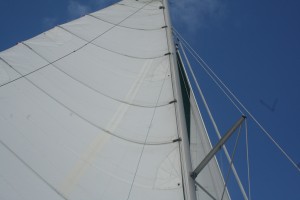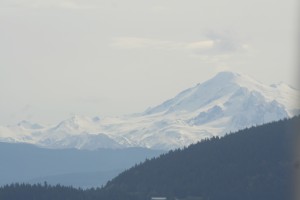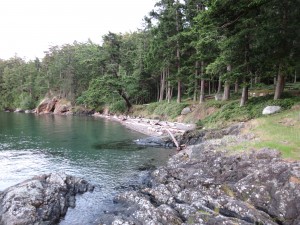We take so many things for granted on land. Water appears to pour from an endless well and electricity is immediate at the flick of a switch. On the ocean, however, these luxuries have to be rationed as we can only use what we can store. In addition, any waste products, such as black water, have to be stored, and disposed of responsibly. Whilst out at sea, for example, human waste was carried around with us until it could be ‘pumped out’ at Roche Harbor. The Gato Verde had two holding tanks for the purposes of storing human waste. The three weeks spent on the Gato Verde have certainly helped me to understand and appreciate how much more sustainable we can all live. In the past when I have heard the term sustainability, I have automatically associated this with either a big change in lifestyle or a large investment. The reality, however, is that we can all live healthier and more sustainable lives if we just use things in moderation.  Whilst out on Gato, as part of our morning chore rotations, measurements were taken of water usage, sewage level, and amount of biodiesel used. This allowed us to graph and monitor our footprint over the duration of the trip.
Compared to many vessels, the Gato Verde, a 42 ft electric biodiesel hybrid catamaran , is pretty special in that it was modified to be more environmentally friendly. Such modifications include converting to LED lights, and changing the sail plan to optimize efficiency. This involved adding a screecher to take full advantage of any wind, and by making the main sail a ‘square top’ to increase surface area. There is no cleaner fuel than the wind itself. If there is little wind then the Gato uses quiet electric motors to help it move through the water. Compared to most motors, these have little noise impact on the environment. The Gato also burns biodiesel, a renewable fuel source, that not only powers the vessel through the water, but, also can be utilized to charge the boats batteries.  Despite the Gato’s current success in being sustainable, further modifications are being considered for the foreseeable future. In the short term, Captain Todd hopes to add solar panels and a wind generator to be even more energy independent. Research is also being directed into alternative grey water systems.
Although we were busy collecting physical oceanography measurements such as conductivity, salinity, visibility, and plankton density, there were a number of opportunities for us to learn about the Gato and the process of sailing. In the early stages, there was so much terminology to get our heads around and knots such as bowlines and sheet bends seemed impossible. In the latter part of our trip, however, this new language felt a lot more natural. For example, when asked to pull in the jib, I knew that this was the middle sail (not to be confused with the main sail or screecher). The masts supporting these sails were themselves held in place by a forestay and shrouds. Out of all the sails, we used the jib the most as it is designed to operate in lighter winds. By using the wind to our advantage, less fuel was needed to travel the same distance. In addition to using the wind, tides and currents were also exploited. By using the environment we could ultimately be more sustainable. After long days of science, we would head back to either moor or dock on nearby islands. Out of all the places we visited, my favourite was Patos Island. On occasions, we were forced to anchor. This however was avoided wherever possible because of the damage it inflicts on the marine environment. Towards the end of the two weeks, we could prepare the anchor with as little as two students. We were mostly responsible for directing Captain Todd, operating the windlass, and preparing the bridle. The idea behind the bridle is that once attached,  it helps to distribute the stress on the boat. The final stage of the  anchoring process involved attaching the chain hook.

Raise the main sail

View from my berth
It was a sad moment when the Gato sailed off from the Friday Harbor labs. Although I was happy to be back on land, I am now itching to get back on the water. I feel that living onboard the Gato has prepared me well for the future. In the space of two short weeks we have learnt so much, skills that will last a lifetime.
Read More
We’ve been back on land for two days now and we’re all still adjusting to life on solid ground. I used to think that from my experiences as a kid on a sailboat, that I knew what it was like to live on a boat… that couldn’t have been farther from the truth. After two weeks on the boat we only just began to scratch the surface of what living in the field is like. It was like no experience I’ve ever had, and I will never be the same because of it. In attempt to stop you from thinking that this experience was anything less than incredible I will give you a little behind the scenes glance of what it was like, and how much fun we actually  had. Our days normally started around 8:00 am in the galley for breakfast. After that we took care of our chores for the day which ranged from cleaning the decks and heads to acting as the navigator and mapping a course for the day. We were able to stay at some pretty amazing islands, like Jones pictured below.

Since our days with whales were limited we collected a lot of physical oceanographic data from the CTD and other equipment like the Secchi disk which measures visibility in the water. We even had the opportunity to sample at one site for the entire day to see how the ocean changed at that one location over time.As the days without whales continued we became more creative with our data collection. It was in these days that we learned how far we were willing to go for our research. Phinn, one of the other students, decided to jump in the water every hour for 7 hours during the day to get horizontal secchi measurements as opposed to the usual vertical readings. After jumping into 8 degC water ourselves earlier that week this seemed absolutely crazy. Even so we jumped in again on a later day and swam around for 25 minutes. With the Olympic mountains in the background it was absolutely breathtaking… oh wait that was the water.
After a week on the boat with no reports of whales we were getting antsy. We delved into collecting as much data as we could and in turn analyzing that data, which I am still doing. We were very successful in collecting a lot of data. Finally we ran into some luck and heard of the whales coming in through the Strait of Juan de Fuca. Even though we woke up at 5:00 am to listen to hydrophones we missed them passing our anchorage and we had to play a bit of catch up. We eventually caught up to the whales and were able to collect both behavioral and acoustic data using the 4 hydrophone array. Suddenly our other needs became secondary and we adjusted course to follow the whales. We ended up having two more days with the whales as they led us from one end of the Salish Sea to the other. Our last day with them was amazing. We were with the whales for about 2 hours and witnessed some amazing behavior like spyhops, tail slaps, and even a few breaches. All of this set against the background of the sun setting on the horizon. While we had some struggles with adjusting to this life style it was an absolutely amazing experience that was hard to walk away from.

What made this experience so special was the boat we were on, The Gato Verde. This is no ordinary boat, it is the first plug in diesel electric hybrid charter boat on the west coast. Stretching to a luxurious 42 ft the Gato was an incredible home away from home. It isn’t special simply because of the amount of space aboard, but because the boat is a pioneer in the field of sustainable boating. Most boats have a motor that runs on gasoline that in turn powers the propellers which move the boat through the water, but the Gato isn’t like any other boat. Captain Todd Shuster added a diesel generator, and a large battery bank in order to make the boat more green. The generator runs on diesel which is cleaner and less explosive than gasoline and the battery banks helps create more clean energy. This would be all fine and dandy by itself, but the Captain took the extra step and taught us about why he made the changes to the boat and how it is creating more sustainable travel and less impact on the environment.
As part of our course we learned about sailing and the different parts of the boat. We even had a knot tying lecture, I can now tie several knots including a reef knot, clove hitch, and cleat hitch. The cruise began with us as students learning about the different aspects of sailing and quickly turned us into actual sailors. We regularly helped raise the jib for sailing and deployed the anchor at nights when we were not on a dock or mooring buoy. We did not get much ideal weather for sailing but when we did we made sure to take advantage of the wind and put our mainsail up. Sailing is another example of how the boat is green. When we had ideal weather conditions we could take advantage of our environment, turn the motor off and use the power of the wind to move the boat. While docked one night we rested next to another sail boat that had a wind generator. This acts like a small turbine that harnesses wind energy and can be used to power the boat. Adding this to the Gato would be yet another way to make the boat more sustainable. One aspect of sustainability still being addressed is the issue of blackwater. Blackwater is waste water loaded with  biological material like feces. Living on a boat we naturally accumulated black water that was stored in holding tanks since we could not just dump the waste into the ocean. It poses a danger to the environment due to the amount of bacteria and contaminants from human waste that are not naturally occurring in the ocean. So we had to pump out our waste at pumping stations like the one in Roche Harbor.
While some aspects of living on a boat were challenging, like timing our location with our need to pump out our holding tanks, and living in such close proximity to people, this was the most amazing experience of my life. I learned so much about the Salish Sea and clean boating as well as about myself and just how far my limits reach. I am sad that our time on the Gato has come to an end, but now I get to analyze the results from all of the data we took and put my piece into the larger puzzle that is the Salish Sea.
Read More







 Twitter
Twitter LinkedIn
LinkedIn Facebook
Facebook